
 Among the many interesting sites
of Zagreb's "Old Town" perhaps the most unique is the Cric
Tunnel, a 350-meter spine cutting across the area between the
upper town and Gornji Grad. The tunnels were built during World
War II as a bomb shelter and after the war it was briefly used
as a food warehouse, but fell into disuse shortly after that.
The central hall (now the Rain Room) was renovated during the
height of Cold War tensions. After a period where it was a
defacto home for the indigent, in 1993 it served as the site of
the Under City Rave, one of the first raves in Croatia,
while it was under the ownership of the Museum of Contemporary
Art. A year later it was a part of the city's Earth Day
celebration. The tunnels underwent a further renovation, opening
to the public two years later. In the ensuing years, it has
hosted historical exhibitions, as well as Advent celebrations.
Unfortunately, visiting during the time of Covid-19, the tunnel
are once again bare.
Among the many interesting sites
of Zagreb's "Old Town" perhaps the most unique is the Cric
Tunnel, a 350-meter spine cutting across the area between the
upper town and Gornji Grad. The tunnels were built during World
War II as a bomb shelter and after the war it was briefly used
as a food warehouse, but fell into disuse shortly after that.
The central hall (now the Rain Room) was renovated during the
height of Cold War tensions. After a period where it was a
defacto home for the indigent, in 1993 it served as the site of
the Under City Rave, one of the first raves in Croatia,
while it was under the ownership of the Museum of Contemporary
Art. A year later it was a part of the city's Earth Day
celebration. The tunnels underwent a further renovation, opening
to the public two years later. In the ensuing years, it has
hosted historical exhibitions, as well as Advent celebrations.
Unfortunately, visiting during the time of Covid-19, the tunnel
are once again bare.
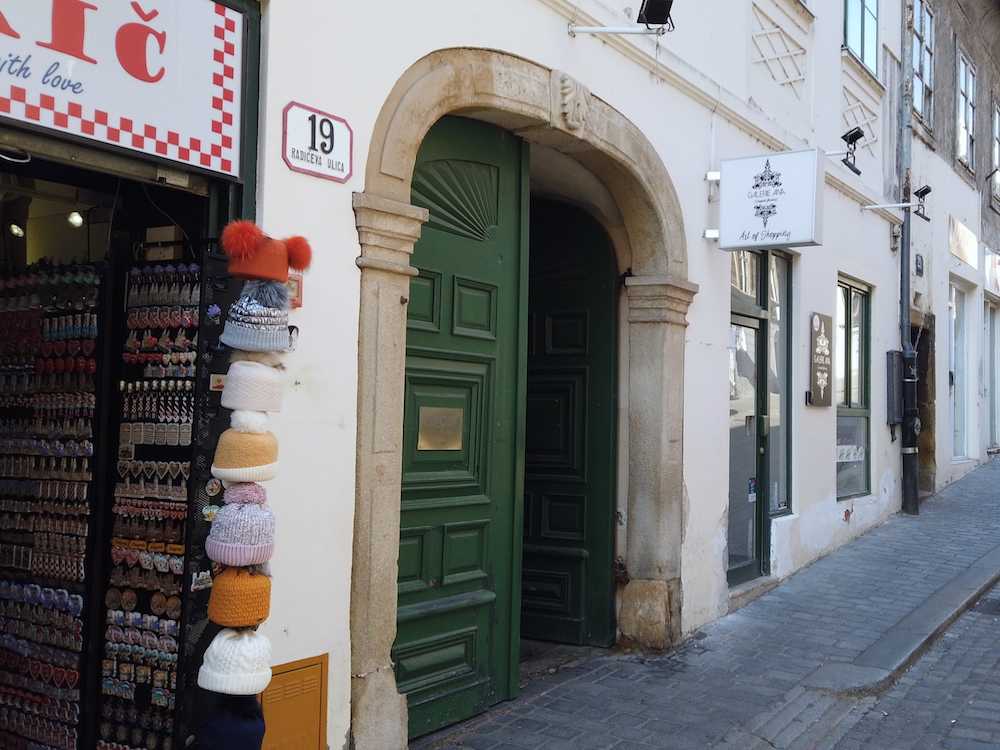
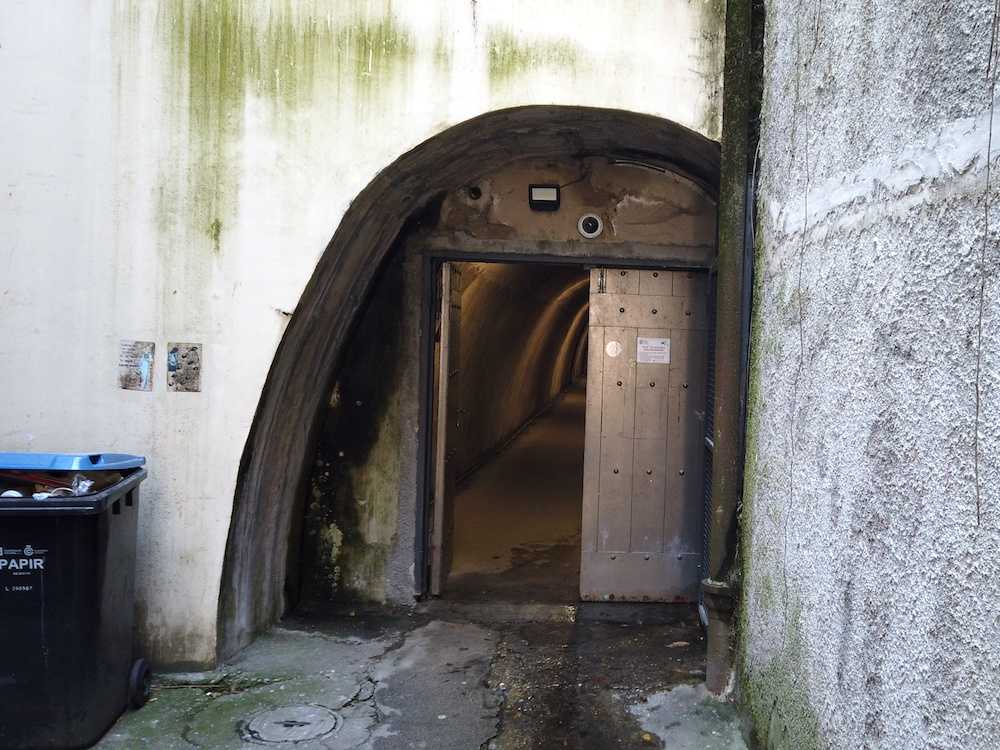 Our tour of the Cric Tunnels
begins Radiceva entrance, the street that leads to the Upper
Town. Passing between the wooden doors adjacent to the Cric
Souvenir shop (there are no tunnel souvenirs, sadly), the actual
entrance is about 25 meters inside. The photo to the left shows
the Radiceva street entrance, while the photo to the left shows
the actual entrance to the tunnel.
Our tour of the Cric Tunnels
begins Radiceva entrance, the street that leads to the Upper
Town. Passing between the wooden doors adjacent to the Cric
Souvenir shop (there are no tunnel souvenirs, sadly), the actual
entrance is about 25 meters inside. The photo to the left shows
the Radiceva street entrance, while the photo to the left shows
the actual entrance to the tunnel.
Entering the Cric Tunnels

 The first tunnel
that branches off to the left connects the main street of
llica, which runs past the main square, Ban Jelajic. The photo
to the left shows the entrance to the tunnel, which is
located just past the Caffe bar Vespa, while the photo to
the right shows the entrance from Illica. The actual tunnel
entrance is about 75 meters from the street entrance, and is
very easy to miss.
The first tunnel
that branches off to the left connects the main street of
llica, which runs past the main square, Ban Jelajic. The photo
to the left shows the entrance to the tunnel, which is
located just past the Caffe bar Vespa, while the photo to
the right shows the entrance from Illica. The actual tunnel
entrance is about 75 meters from the street entrance, and is
very easy to miss.
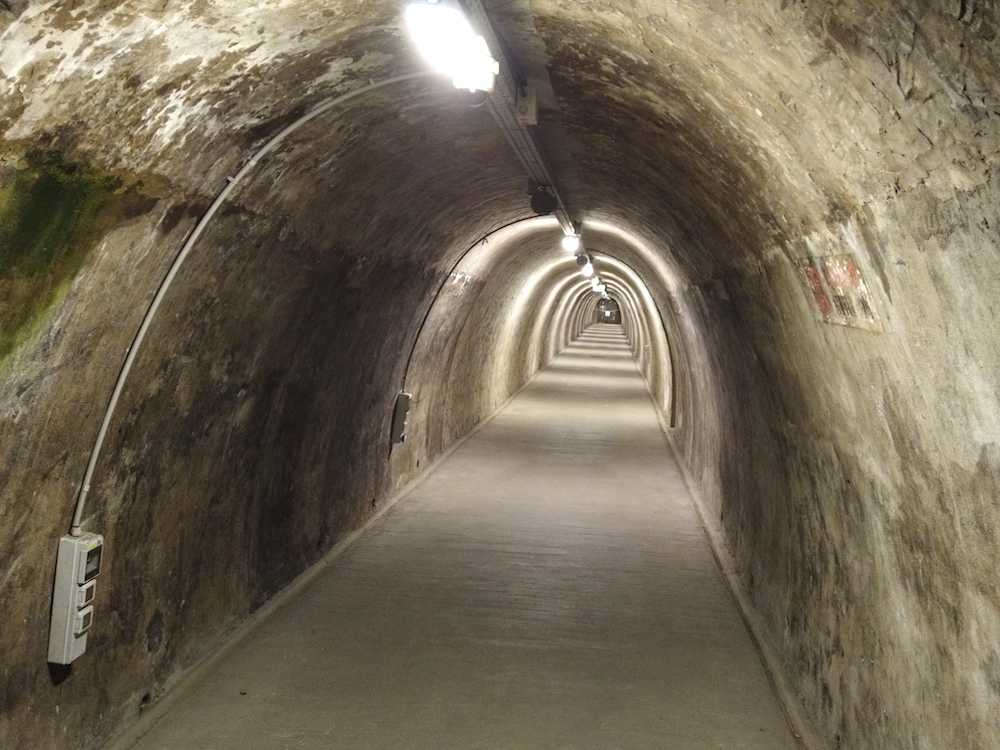
 There seemed to be more access
tunnels leading to the south than are captured on the map--the
second tunnel was a case in point. It is a long offshoot,
probably 80 meters or so long, and at the end there is a chain
in front of the exit door. The photo to the left shows a
view down the tunnel, while the photo to the right shows
visittors that they have reached the end of the line. At least
it was warm, compared to the 34 degree temperature outside.
According to Wikipedia,
there were two Ilica Street entrances, so perhaps this is the
second one.
There seemed to be more access
tunnels leading to the south than are captured on the map--the
second tunnel was a case in point. It is a long offshoot,
probably 80 meters or so long, and at the end there is a chain
in front of the exit door. The photo to the left shows a
view down the tunnel, while the photo to the right shows
visittors that they have reached the end of the line. At least
it was warm, compared to the 34 degree temperature outside.
According to Wikipedia,
there were two Ilica Street entrances, so perhaps this is the
second one.
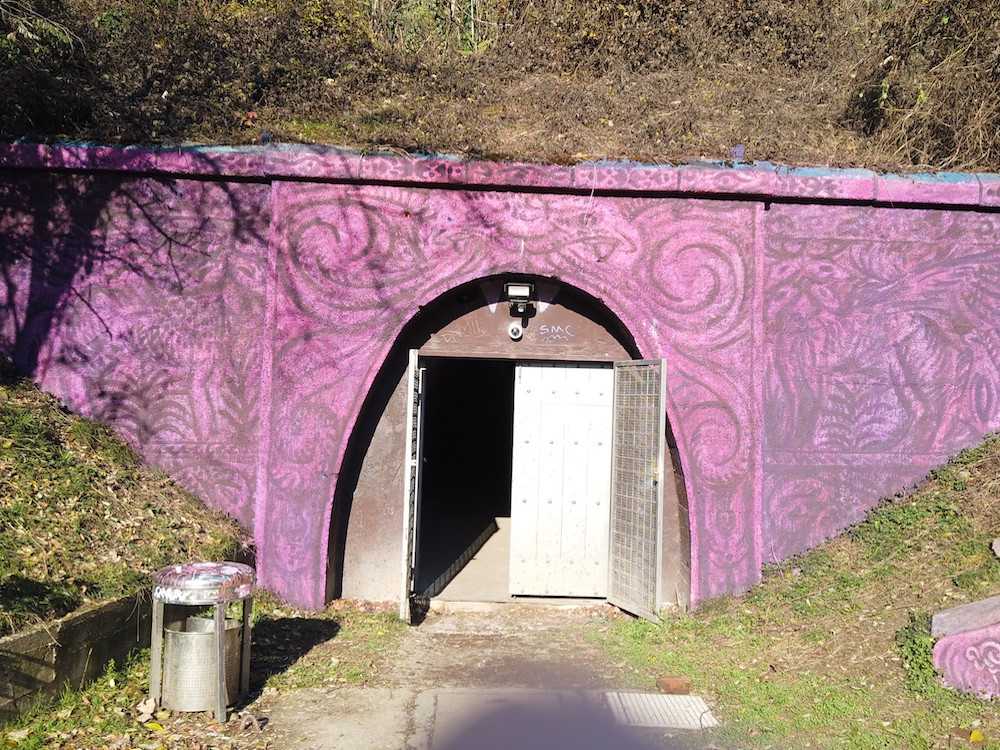
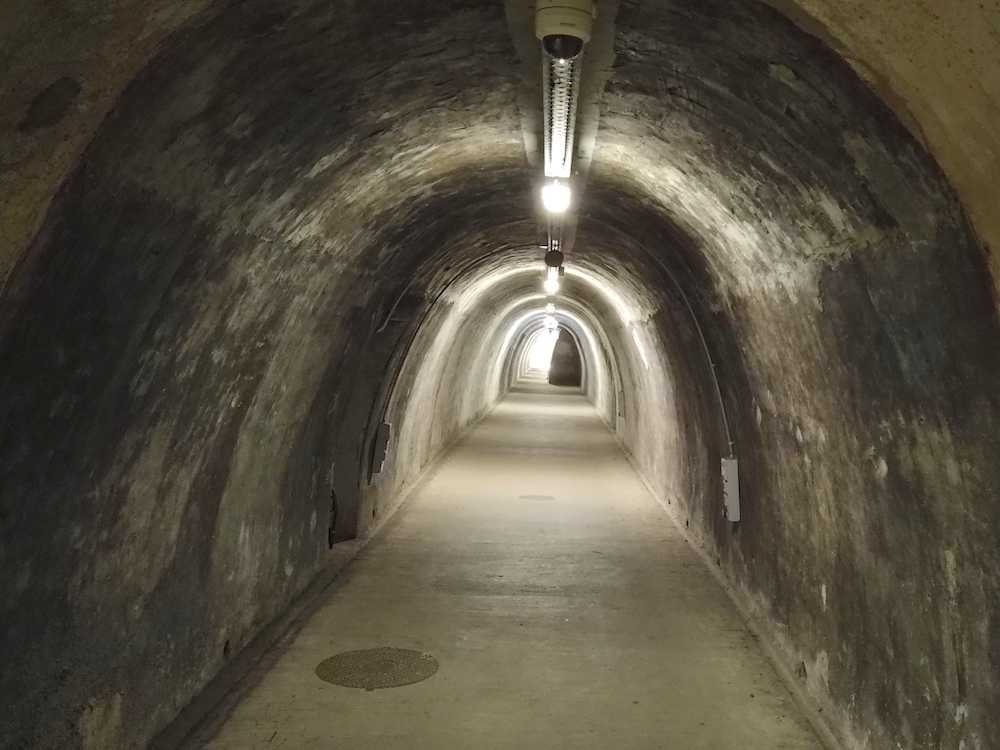 The Third tunnel (I could not
verify the street address where it came out, as a fence
separated the tunnel entrance from access to a main street,
presumably Ilica again) open onto a small ledge, with stairs
leading to the street level. Again, a wire fence with a locked
gate prevented further exploration. Judging from the location on
Google Maps, it may be the Tomiceva entrance. When I exited the
tunnel, a worker was just finishing touchups on the purple
exterior. Like the next two exits, this one had washroom
facilities just inside, indicating that it must normally be open
to the public. The photo to the left shows the view from the
main passageway, while the photo to the left shows the painted
tunnel entrance.
The Third tunnel (I could not
verify the street address where it came out, as a fence
separated the tunnel entrance from access to a main street,
presumably Ilica again) open onto a small ledge, with stairs
leading to the street level. Again, a wire fence with a locked
gate prevented further exploration. Judging from the location on
Google Maps, it may be the Tomiceva entrance. When I exited the
tunnel, a worker was just finishing touchups on the purple
exterior. Like the next two exits, this one had washroom
facilities just inside, indicating that it must normally be open
to the public. The photo to the left shows the view from the
main passageway, while the photo to the left shows the painted
tunnel entrance.
 As you can see from the map at the top of
the page, midway between the main entrances lies a much larger
and open central hall, which is identified in the map above as
a "Rain Room." The central underground hall has been
turned into a Rain Room where visitors walk under water drops
(umbrellas are provided by the Tunnel) and images of famous
persons of Croatia are displayed, with holograms of the first
female proffesional journalist in Croatia Marija Juric Zagorka,
Croatian poet Antun Gustav Matos, Manda (from the legend of
Mandusevac, the origin story of Zagreb) and other historical and
cultural figures in drops of water. There was no evidence
of this on the day that I visited, so I don't know if this is
still operating. The central hall was where goods were stored
when the tunnel served as a warehouse.
As you can see from the map at the top of
the page, midway between the main entrances lies a much larger
and open central hall, which is identified in the map above as
a "Rain Room." The central underground hall has been
turned into a Rain Room where visitors walk under water drops
(umbrellas are provided by the Tunnel) and images of famous
persons of Croatia are displayed, with holograms of the first
female proffesional journalist in Croatia Marija Juric Zagorka,
Croatian poet Antun Gustav Matos, Manda (from the legend of
Mandusevac, the origin story of Zagreb) and other historical and
cultural figures in drops of water. There was no evidence
of this on the day that I visited, so I don't know if this is
still operating. The central hall was where goods were stored
when the tunnel served as a warehouse.

 There were numerous
stencil signs, mostly faded, that lined the entire 350-meter
route. Given my limited knowledge of Croatian (7 words and
counting), I can barely hazard a guess as to their meaning. The
problem is compounded by the fact that key elements of the
phrases are badly faded. The photo to the left says something
about leaving, while the photo to the right is some sort of
warning. Fortunately, I was not threatened by a nuclear attack,
so I could safely ignore them.
There were numerous
stencil signs, mostly faded, that lined the entire 350-meter
route. Given my limited knowledge of Croatian (7 words and
counting), I can barely hazard a guess as to their meaning. The
problem is compounded by the fact that key elements of the
phrases are badly faded. The photo to the left says something
about leaving, while the photo to the right is some sort of
warning. Fortunately, I was not threatened by a nuclear attack,
so I could safely ignore them.

 The final two south
facing tunnels lead to the Art Park and are labeled Art Park 2
and Art Park 1 respectively (moving from east to west). Although
both were closed when we visited, they appeared to be identical,
and most likely were another popular entrance, as they both
feature washroom facilities at the now-closed entrances. The
photo to the left shows one of the Art Park entrances, while the
photo to the right shows the facilities at the entrances.
The final two south
facing tunnels lead to the Art Park and are labeled Art Park 2
and Art Park 1 respectively (moving from east to west). Although
both were closed when we visited, they appeared to be identical,
and most likely were another popular entrance, as they both
feature washroom facilities at the now-closed entrances. The
photo to the left shows one of the Art Park entrances, while the
photo to the right shows the facilities at the entrances.
 Beyond the final two
Art Park side tunnels lies the the west entrance on Mesnicka
Ulica. This is the most popular entrance, located at the base of
the beautiful Strossmayer Promenade. The location is just below
the promenade, and is shown in the photo to the left. While it
was somewhat disappointing that all the previous historical and
social exhibits were removed and the advent festvities no longer
find a home there (at least not in 2021), it is hoped that they
will again one day serve as an exhibition center and not merely
a pedestrian walkway. Before leaving the topic, below is a short
video of the tunnels in happier times, during the Advent
festivities.
Beyond the final two
Art Park side tunnels lies the the west entrance on Mesnicka
Ulica. This is the most popular entrance, located at the base of
the beautiful Strossmayer Promenade. The location is just below
the promenade, and is shown in the photo to the left. While it
was somewhat disappointing that all the previous historical and
social exhibits were removed and the advent festvities no longer
find a home there (at least not in 2021), it is hoped that they
will again one day serve as an exhibition center and not merely
a pedestrian walkway. Before leaving the topic, below is a short
video of the tunnels in happier times, during the Advent
festivities.
The Cric Tunnels During Advent
2


 Among the many interesting sites
of Zagreb's "Old Town" perhaps the most unique is the Cric
Tunnel, a 350-meter spine cutting across the area between the
upper town and Gornji Grad. The tunnels were built during World
War II as a bomb shelter and after the war it was briefly used
as a food warehouse, but fell into disuse shortly after that.
The central hall (now the Rain Room) was renovated during the
height of Cold War tensions. After a period where it was a
defacto home for the indigent, in 1993 it served as the site of
the Under City Rave, one of the first raves in Croatia,
while it was under the ownership of the Museum of Contemporary
Art. A year later it was a part of the city's Earth Day
celebration. The tunnels underwent a further renovation, opening
to the public two years later. In the ensuing years, it has
hosted historical exhibitions, as well as Advent celebrations.
Unfortunately, visiting during the time of Covid-19, the tunnel
are once again bare.
Among the many interesting sites
of Zagreb's "Old Town" perhaps the most unique is the Cric
Tunnel, a 350-meter spine cutting across the area between the
upper town and Gornji Grad. The tunnels were built during World
War II as a bomb shelter and after the war it was briefly used
as a food warehouse, but fell into disuse shortly after that.
The central hall (now the Rain Room) was renovated during the
height of Cold War tensions. After a period where it was a
defacto home for the indigent, in 1993 it served as the site of
the Under City Rave, one of the first raves in Croatia,
while it was under the ownership of the Museum of Contemporary
Art. A year later it was a part of the city's Earth Day
celebration. The tunnels underwent a further renovation, opening
to the public two years later. In the ensuing years, it has
hosted historical exhibitions, as well as Advent celebrations.
Unfortunately, visiting during the time of Covid-19, the tunnel
are once again bare.
 Our tour of the Cric Tunnels
begins Radiceva entrance, the street that leads to the Upper
Town. Passing between the wooden doors adjacent to the Cric
Souvenir shop (there are no tunnel souvenirs, sadly), the actual
entrance is about 25 meters inside. The photo to the left shows
the Radiceva street entrance, while the photo to the left shows
the actual entrance to the tunnel.
Our tour of the Cric Tunnels
begins Radiceva entrance, the street that leads to the Upper
Town. Passing between the wooden doors adjacent to the Cric
Souvenir shop (there are no tunnel souvenirs, sadly), the actual
entrance is about 25 meters inside. The photo to the left shows
the Radiceva street entrance, while the photo to the left shows
the actual entrance to the tunnel.
 The first tunnel
that branches off to the left connects the main street of
llica, which runs past the main square, Ban Jelajic. The photo
to the left shows the entrance to the tunnel, which is
located just past the Caffe bar Vespa, while the photo to
the right shows the entrance from Illica. The actual tunnel
entrance is about 75 meters from the street entrance, and is
very easy to miss.
The first tunnel
that branches off to the left connects the main street of
llica, which runs past the main square, Ban Jelajic. The photo
to the left shows the entrance to the tunnel, which is
located just past the Caffe bar Vespa, while the photo to
the right shows the entrance from Illica. The actual tunnel
entrance is about 75 meters from the street entrance, and is
very easy to miss.
 There seemed to be more access
tunnels leading to the south than are captured on the map--the
second tunnel was a case in point. It is a long offshoot,
probably 80 meters or so long, and at the end there is a chain
in front of the exit door. The photo to the left shows a
view down the tunnel, while the photo to the right shows
visittors that they have reached the end of the line. At least
it was warm, compared to the 34 degree temperature outside.
According to Wikipedia,
there were two Ilica Street entrances, so perhaps this is the
second one.
There seemed to be more access
tunnels leading to the south than are captured on the map--the
second tunnel was a case in point. It is a long offshoot,
probably 80 meters or so long, and at the end there is a chain
in front of the exit door. The photo to the left shows a
view down the tunnel, while the photo to the right shows
visittors that they have reached the end of the line. At least
it was warm, compared to the 34 degree temperature outside.
According to Wikipedia,
there were two Ilica Street entrances, so perhaps this is the
second one.
 The Third tunnel (I could not
verify the street address where it came out, as a fence
separated the tunnel entrance from access to a main street,
presumably Ilica again) open onto a small ledge, with stairs
leading to the street level. Again, a wire fence with a locked
gate prevented further exploration. Judging from the location on
Google Maps, it may be the Tomiceva entrance. When I exited the
tunnel, a worker was just finishing touchups on the purple
exterior. Like the next two exits, this one had washroom
facilities just inside, indicating that it must normally be open
to the public. The photo to the left shows the view from the
main passageway, while the photo to the left shows the painted
tunnel entrance.
The Third tunnel (I could not
verify the street address where it came out, as a fence
separated the tunnel entrance from access to a main street,
presumably Ilica again) open onto a small ledge, with stairs
leading to the street level. Again, a wire fence with a locked
gate prevented further exploration. Judging from the location on
Google Maps, it may be the Tomiceva entrance. When I exited the
tunnel, a worker was just finishing touchups on the purple
exterior. Like the next two exits, this one had washroom
facilities just inside, indicating that it must normally be open
to the public. The photo to the left shows the view from the
main passageway, while the photo to the left shows the painted
tunnel entrance.  As you can see from the map at the top of
the page, midway between the main entrances lies a much larger
and open central hall, which is identified in the map above as
a "Rain Room." The central underground hall has been
turned into a Rain Room where visitors walk under water drops
(umbrellas are provided by the Tunnel) and images of famous
persons of Croatia are displayed, with holograms of the first
female proffesional journalist in Croatia Marija Juric Zagorka,
Croatian poet Antun Gustav Matos, Manda (from the legend of
Mandusevac, the origin story of Zagreb) and other historical and
cultural figures in drops of water. There was no evidence
of this on the day that I visited, so I don't know if this is
still operating. The central hall was where goods were stored
when the tunnel served as a warehouse.
As you can see from the map at the top of
the page, midway between the main entrances lies a much larger
and open central hall, which is identified in the map above as
a "Rain Room." The central underground hall has been
turned into a Rain Room where visitors walk under water drops
(umbrellas are provided by the Tunnel) and images of famous
persons of Croatia are displayed, with holograms of the first
female proffesional journalist in Croatia Marija Juric Zagorka,
Croatian poet Antun Gustav Matos, Manda (from the legend of
Mandusevac, the origin story of Zagreb) and other historical and
cultural figures in drops of water. There was no evidence
of this on the day that I visited, so I don't know if this is
still operating. The central hall was where goods were stored
when the tunnel served as a warehouse.
 There were numerous
stencil signs, mostly faded, that lined the entire 350-meter
route. Given my limited knowledge of Croatian (7 words and
counting), I can barely hazard a guess as to their meaning. The
problem is compounded by the fact that key elements of the
phrases are badly faded. The photo to the left says something
about leaving, while the photo to the right is some sort of
warning. Fortunately, I was not threatened by a nuclear attack,
so I could safely ignore them.
There were numerous
stencil signs, mostly faded, that lined the entire 350-meter
route. Given my limited knowledge of Croatian (7 words and
counting), I can barely hazard a guess as to their meaning. The
problem is compounded by the fact that key elements of the
phrases are badly faded. The photo to the left says something
about leaving, while the photo to the right is some sort of
warning. Fortunately, I was not threatened by a nuclear attack,
so I could safely ignore them.
 The final two south
facing tunnels lead to the Art Park and are labeled Art Park 2
and Art Park 1 respectively (moving from east to west). Although
both were closed when we visited, they appeared to be identical,
and most likely were another popular entrance, as they both
feature washroom facilities at the now-closed entrances. The
photo to the left shows one of the Art Park entrances, while the
photo to the right shows the facilities at the entrances.
The final two south
facing tunnels lead to the Art Park and are labeled Art Park 2
and Art Park 1 respectively (moving from east to west). Although
both were closed when we visited, they appeared to be identical,
and most likely were another popular entrance, as they both
feature washroom facilities at the now-closed entrances. The
photo to the left shows one of the Art Park entrances, while the
photo to the right shows the facilities at the entrances. Beyond the final two
Art Park side tunnels lies the the west entrance on Mesnicka
Ulica. This is the most popular entrance, located at the base of
the beautiful Strossmayer Promenade. The location is just below
the promenade, and is shown in the photo to the left. While it
was somewhat disappointing that all the previous historical and
social exhibits were removed and the advent festvities no longer
find a home there (at least not in 2021), it is hoped that they
will again one day serve as an exhibition center and not merely
a pedestrian walkway. Before leaving the topic, below is a short
video of the tunnels in happier times, during the Advent
festivities.
Beyond the final two
Art Park side tunnels lies the the west entrance on Mesnicka
Ulica. This is the most popular entrance, located at the base of
the beautiful Strossmayer Promenade. The location is just below
the promenade, and is shown in the photo to the left. While it
was somewhat disappointing that all the previous historical and
social exhibits were removed and the advent festvities no longer
find a home there (at least not in 2021), it is hoped that they
will again one day serve as an exhibition center and not merely
a pedestrian walkway. Before leaving the topic, below is a short
video of the tunnels in happier times, during the Advent
festivities.